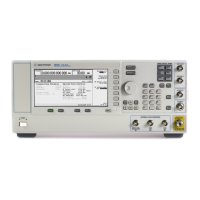Chapter 3 95
Basic Digital Operation
Using the Dual ARB Waveform Player
Adding Real–Time Noise to a Dual ARB Waveform (E8267D with Option 403)
The signal generator with option 403 can apply AWGN (additive white gaussian noise) to a carrier in
real time while the modulating waveform file is being played by the Dual ARB waveform player. The
AWGN can be configured using front panel softkeys. The
Carrier to Noise Ratio softkey allows you to
specify the amount of noise power relative to carrier power that is applied to the signal. The
Carrier
Bandwidth
softkey sets the bandwidth over which the noise is integrated and the Noise Bandwidth Factor
softkey allows you to select a flat noise bandwidth. The
Output Mux softkey enables diagnostic control
of additive noise, so that only the noise, only the carrier, or the sum of both the noise and the
carrier are output from the internal baseband generator. With the ALC off, this feature enables direct
measurement of the carrier or the noise contributions independently from the total power. The
system still behaves as if both the noise and the carrier are present on the output when it comes to
determining the Auto Modulation Attenuation and the RMS level for RMS Power Search.
These softkeys are described in the Agilent PSG Signal Generators Key Reference.
The following procedure sets up a carrier and modulates it using the pre–defined SINE_TEST_WFM
waveform file. AWGN is then applied to the carrier.
Configuring AWGN
1. Preset the signal generator. Press the
Preset hardkey.
2. Press the
Frequency hardkey and enter 15 GHz.
3. Press the
Amplitude hardkey and enter –10 dBm.
4. Press
RF On Off to On.
5. Press
Mode > Dual ARB > Select Waveform and select the SINE_TEST_WFM waveform.
6. Press
Select Waveform.
7. Press
ARB Off On to On.
8. Press
ARB Setup > ARB Sample Clock enter 50 MHz.
9. Press
Real–time Noise Setup > Carrier to Noise Ratio and enter 30 dB.
10. Press
Carrier Bandwidth and enter 40 MHz.
11. Press
Real–time Noise Off On to On.
This procedure applies AWGN to the 15 GHz carrier. The displayed power level of the signal
generator, –10 dBm, will include the noise power which is set as a carrier to noise ratio (C/N) of
30 dB. Noise power, for the purpose of C/N, is applied across a carrier bandwidth of 40 MHz. The
default noise bandwidth factor is 1, which provides a flat noise signal bandwidth of a least 0.8 times
the 50 MHz sample rate.
Storing and Loading Waveform Segments
Waveform segments can reside in volatile memory as WFM1 files, or they can be stored to
non–volatile memory as NVWFM files, or both. To play or edit a waveform file, it must reside in
volatile memory. Because files stored in volatile memory do not survive a power cycle, it is a good
practice to store important files to non–volatile memory and load them to volatile memory whenever
you want to use them.

